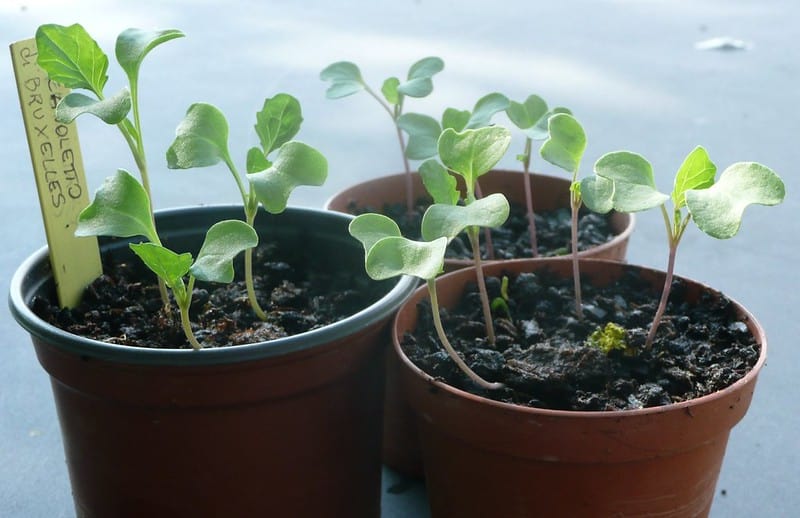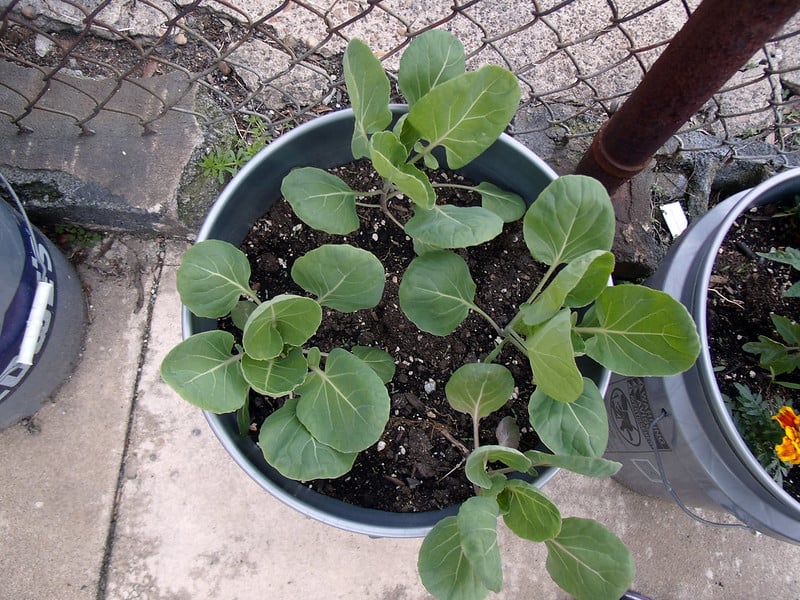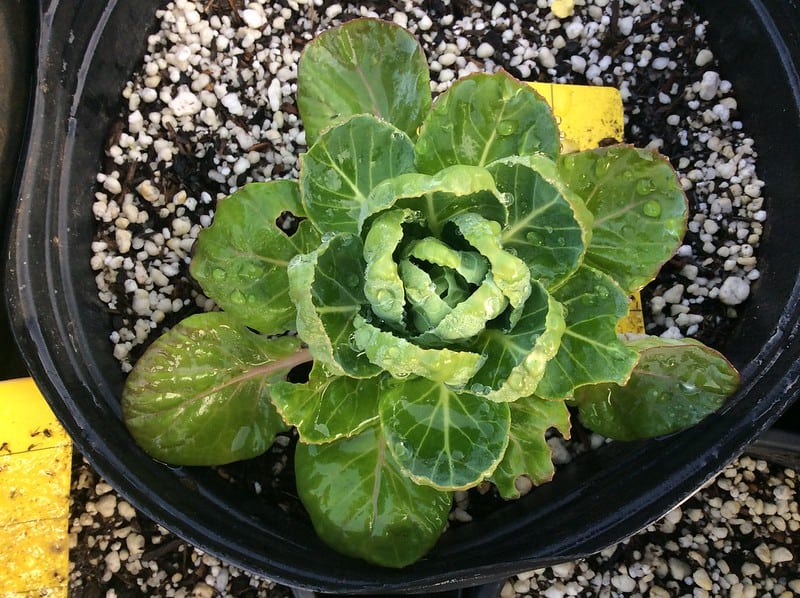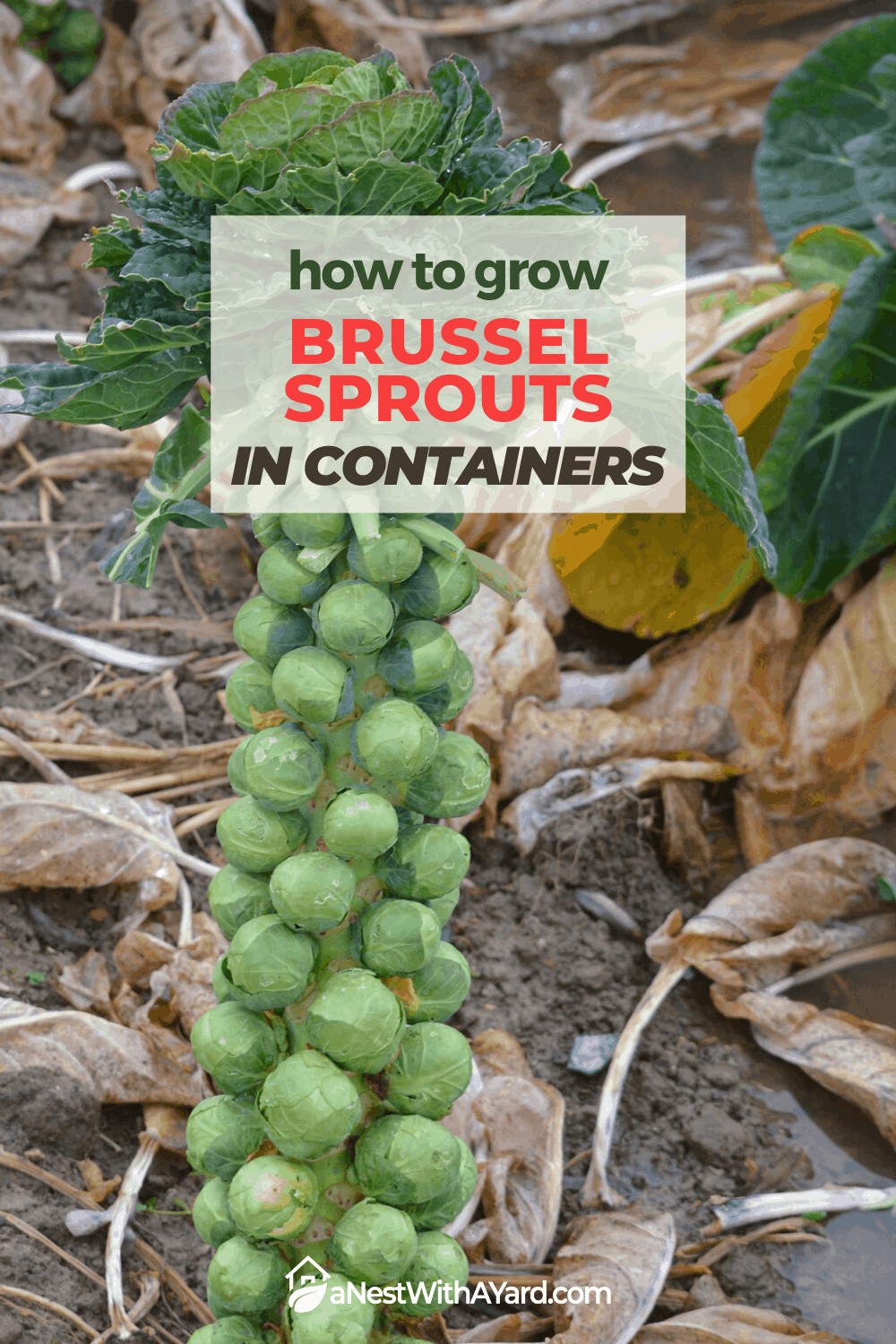Here are the steps in the nutshell:
- Fill a 1-foot-deep container with well-draining potting soil.
- Mix in 1.5 tablespoons of 14-14-14 controlled-release fertilizer.
- Water the soil thoroughly.
- Transplant the seedling.
- Keep the soil moist.
- Regularly apply 15-30-15 fertilizer.
- Harvest brussels sprouts when they’re 1-2 inches in diameter.
Contents
Love Brussels Sprouts? Grow Your Own!
People seem to either love or hate brussels sprouts. If you’re in the former category, I have good news — growing brussel sprouts in containers is easy!
I chose this topic because I want more people to eat healthy and discover the joys of gardening.
Brussels sprouts are rich in vitamins C and K, fiber, and antioxidants. Plus, growing them is fascinating. Want to harvest fresh brussels sprouts like these from your patio? Keep reading!
Here’s What You’ll Need
An asterisk * next to an item means you have multiple options, which I’ll discuss below.
- A 1-foot-wide by 1-foot-deep container
- Potting mix *
- 14-14-14 controlled-release fertilizer
- 15-30-15 soluble fertilizer
- A 1-gallon container
- A brussels sprout seedling*
- A full-sun location
- Pruning shears
- A hand shovel or other transplanting tool
Potting Soil Vs Potting Mix
Potting soil is any soil-containing growing medium used for container gardening, whereas potting mix contains no soil.
Potting mix is ideal for growing brussel sprouts in pots, but potting soil is usually cheaper and can be used indefinitely if you amend it. Potting mix gradually breaks down and becomes useless.
Knowing how to grow brussel sprouts in a pot means understanding how containers affect their growing mediums. The problem with using soil in containers is that it tends to get compacted, which can suffocate plant roots and retain too much moisture.
In contrast, potting mix is designed to be fluffy, well-aerated, and well-draining.
You can save money on potting mix by making your own. To do so, follow this tutorial by California Gardening:
Fertilizer
Brussels sprouts need a constant supply of nitrogen, for which you could use an organic fertilizer, like composted manure.
Synthetic fertilizer isn’t necessary, but it does work immediately. In contrast, organic fertilizers release their nutrients slowly. Apart from this, the main reason to choose organic fertilizer over synthetic is that it’s better for the environment.
Grow Your Own Seedlings
You might be able to find brussel sprout seedlings at a gardening center. If not, it isn’t difficult to grow your own.
To grow your own brussel sprout seedlings, you’ll need:
- Seeds
- Potting mix
- Three small, empty plastic containers (like yogurt cups)
- Scissors or a knife
- A misting spray bottle (optional)

Steps
Here are the steps on how to grow your own brussel sprout seedlings:
- Cut Drainage Holes Into Three Small Containers
Planting three seeds makes it more likely that you’ll have one that will germinate and grow properly. Therefore, you should prepare three containers. Use scissors or a knife to poke drainage holes in their undersides. - Fill Each Container With Potting Mix
Leave a little space in each container so it won’t overflow when you water it. - Plant The Seed
Plant a seed in each container, about ½ an inch (1.27 centimeters) deep. - Place The Containers In A Sunny Space
Put the containers in a location that receives at least six hours of direct sunlight daily. It can be indoors or outdoors. - Keep The Soil Moist
It’s a good idea to gently mist tender young seedlings with a spray bottle so they won’t get washed out of place. - Transplant At The Right Time
Your seedlings will be ready to transplant when they’re 5-7 inches (12.7-17.78 centimeters) tall.
Start Growing Brussel Sprouts In Containers With These Steps
Learn how to grow brussel sprouts in containers using the following steps:
- Get A Container
A good container for growing brussel sprouts is at least 1 foot wide (30.48 centimeters) and 1 foot deep. It should also have drainage holes. If you intend to grow brussel sprouts indoors, you should also get a tray to collect drainage water.

- Get Some Potting Mix
The best growing medium for brussel sprouts is well-draining and rich in organic matter. It also needs to be well-aerated and soft. Though you could use potting soil, it’s better to use potting mix.

- Add Fertilizer To The Potting Mix
Fill the container with potting mix. Then, SFGate recommends mixing in 1.5 tablespoons of 14-14-14 controlled-release fertilizer.
If you prefer to use organic fertilizer, rules vary for each type. To use manure, use a ratio of four parts potting mix for every one part manure. Mix them together thoroughly.
- Water The Potting Mix
Before planting the seedling, thoroughly water the potting mix. It will be wet enough when water starts seeping through the container’s drainage holes.
- Plant The Seedlings
Transplant the brussels sprout seedling into the container. If you grew your own, transplant it when it’s 5-7 inches (12.7-17.78 centimeters) tall. I recommend using a small hand shovel for this task, although other tools will work. You can plant more than one seedling in the same pot if it’s big enough.

- Place The Container In A Sunny Location
Brussels sprouts need at least six hours of direct sunlight a day. If you plan to grow yours indoors, a south-facing window is ideal. An east or west-facing window may also work, but a north-facing window won’t have enough light (unless you live in the southern hemisphere).

If you plan to grow them outdoors, it’s a good idea to put mulch around the seedling to preserve moisture and prevent weeds.
- Keep The Potting Mix Moist
How often you should water the potting mix depends on many factors, such as its moisture-holding capacity, the air’s humidity, and the environment’s temperature. If you grow your brussels sprouts outdoors, you will probably have to water them more frequently.

As long as your growing medium and pot have good drainage, you’re unlikely to overwater. But to know when the potting mix actually needs water, you should do a daily moisture test.
One way to test potting mix’s moisture is with a wooden skewer. Stick a wooden skewer about 1-2 inches (2.54 – 5.08 centimeters) into the potting mix. Lift it slowly.
If damp potting mix sticks to the skewer, you don’t need to water your brussels sprout plant. But if the potting mix is dry and easily crumbles off the skewer, it’s time to thoroughly water your plant.
- Fertilize Regularly
In addition to an initial application of 14-14-14 fertilizer, SFGate recommends regularly applying a 15-30-15 soluble fertilizer. Six weeks after planting the seedling in the container, mix a tablespoon of 15-30-15 fertilizer into a gallon of water.
Water your plant with this solution once every two weeks.
If you prefer to use an organic fertilizer, proper application varies for each type. To use composted manure, you can just spread it around your plant as though it were mulch.
- Prune The Plant
When your plant starts developing sprouts, pluck off about eight lower leaves so it can focus its energy on the sprouts.
There will be a growing point near the top of your plant. When the sprouts are 0.5-1 inch (1.27 – 2.54 centimeters) in diameter, cut off the part of the stalk above that point.
For this, it’s best to use pruning shears like the ones in this article. This video shows the process:
*Tip: To prevent disease, always clean cutting tools before using them to prune a plant.
- Harvest Your Fresh Brussel Sprouts!
When the sprouts are 1 to 2 inches (2.54 – 5.08 centimeters) in diameter, harvest them by gently twisting them off the main stalk. You will notice that the lower Brussel sprouts on the stalk will mature the fastest.
Read more in my post about how to harvest Brussels sprouts and when.
Enjoy Growing Brussel Sprouts In Containers!
I hope this tutorial will enable you to enjoy brussels sprouts more often! They’re so delicious and nutritious, not to mention fun because they look like little cabbages.
I also hope that growing brussel sprouts in containers will inspire more people to garden, as it’s a great way to connect with nature without leaving your house. For more small-space garden ideas, check out this article.
Have you enjoyed this tutorial? If you have, please share it with fellow gardeners. Also, if you have any thoughts or concerns, please share them in the comments.
And if you have a severe lack of gardening space, I recommend looking into the Garden Tower 2, a revolutionary gardening tower that can grow 50 plants in only four square feet!



